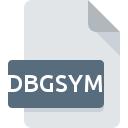.DBGSYM File Extension

Debug Symbols File
| Developer | N/A |
| Popularity | |
| Category | Data Files |
| Format | .DBGSYM |
| Cross Platform | Update Soon |
What is an DBGSYM file?
.DBGSYM files are associated with debugging information in software development. These files contain symbol tables and other metadata crucial for debugging processes. They assist developers in associating memory addresses with corresponding source code lines, function names, and variables, aiding in the identification and resolution of bugs and issues within programs.
More Information.
.DBGSYM files have been used in various programming environments for decades. Initially, they were primarily associated with compiled languages like C and C++, but their usage has expanded to encompass other languages and platforms. The primary purpose remains consistent: to aid developers in debugging by providing essential information about the compiled code’s structure and behavior.
Origin Of This File.
.DBGSYM files originated from the need for efficient debugging processes in software development. As programs grew in complexity, developers required better tools to diagnose and fix issues. Thus, the concept of debug symbol files emerged to provide a mapping between compiled code and the original source code, facilitating easier debugging.
File Structure Technical Specification.
.DBGSYM files typically contain symbol tables, which map memory addresses to corresponding source code elements such as functions, variables, and types. They may also include additional metadata such as debugging information generated by compilers or debuggers. The specific structure and format of these files may vary depending on the programming language, compiler, and platform used.
How to Convert the File?
Windows:
- Open Visual Studio IDE on your Windows system.
- Load the project or solution that corresponds to the .DBGSYM file.
- Navigate to the project properties and ensure that the debugging information generation option is set to include debug symbols.
- Rebuild the project to generate the updated .PDB (Program Database) files, which contain the debug symbols.
- The .PDB files can now be used for debugging purposes in Windows.
Linux:
- Install the necessary debugging tools on your Linux system, such as GDB (GNU Debugger) or objcopy.
- Use objcopy utility with appropriate options to extract debug symbols from the executable or object file associated with the .DBGSYM file.
- Save the extracted debug symbols into a separate file, which can then be used for debugging purposes in Linux.
Mac:
- Install Xcode IDE on your Mac system, which includes LLDB (LLVM Debugger) and other necessary debugging tools.
- Load the Xcode project that corresponds to the .DBGSYM file.
- Ensure that the project settings are configured to generate debug symbols during compilation.
- Build the project to generate the debug symbol information.
- The generated debug symbols can now be used for debugging purposes in Mac OS.
Android:
- Install Android Studio on your development machine.
- Ensure that the Android project associated with the .DBGSYM file is configured to generate debug symbols during the build process.
- Build the project in Android Studio to generate the necessary debug symbol information.
- The generated debug symbols can be utilized for debugging Android applications using tools like Android Studio’s built-in debugger or adb (Android Debug Bridge).
iOS:
- Open Xcode IDE on your Mac system.
- Load the Xcode project corresponding to the .DBGSYM file, which is typically an iOS application project.
- Verify that the project settings are configured to generate debug symbols.
- Build the project in Xcode to generate the debug symbol information.
- The generated debug symbols can be utilized for debugging iOS applications using Xcode’s integrated debugger.
Advantages And Disadvantages.
Advantages of .DBGSYM files include:
- Facilitation of efficient debugging processes
- Enhanced code comprehension for developers
- Improved error diagnosis and resolution
- Compatibility with various development environments and platforms
Disadvantages may include:
- Increased file size due to the inclusion of debug information
- Potential security risks if debug symbols are not properly managed
- Compatibility issues between different versions of debuggers or compilers
How to Open DBGSYM?
Open In Windows
.DBGSYM files can be opened in Windows using compatible debugging tools such as WinDbg or Visual Studio Debugger. Developers can load the corresponding executable file along with its debug symbol file for debugging sessions.
Open In Linux
In Linux, .DBGSYM files can be utilized with debuggers like GDB (GNU Debugger) or LLDB (LLVM Debugger). These tools allow developers to analyze and debug programs compiled on Linux platforms, leveraging the debug symbol information.
Open In MAC
On macOS, developers can use LLDB or other compatible debuggers to open and debug programs with .DBGSYM files. Similar to Linux, these tools provide essential debugging capabilities for macOS applications.
Open In Android
Android developers can employ tools like Android Studio or adb (Android Debug Bridge) along with compatible debuggers to work with .DBGSYM files. These tools facilitate debugging of Android applications on various devices and emulators.
Open In IOS
For iOS development, Xcode offers robust debugging features that support .DBGSYM files. Developers can use Xcode’s integrated debugger to analyze and debug iOS applications compiled with debug symbol information.
Open in Others
Depending on the specific platform or development environment, .DBGSYM files can be opened using appropriate debugging tools and techniques. This may include specialized debuggers for embedded systems, gaming consoles, or other software environments.













